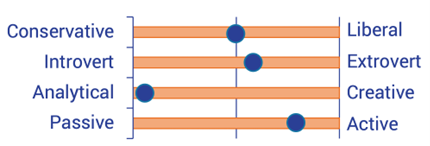The first step in developing a customer journey map is knowing your customer. Sounds basic, right? It’s easy to forget, though, that there is no such thing as a “generic customer” for most businesses. Before we can understand how a customer will interact with our product or service, we have to understand *them*. I recently had an experience that really drove that point home for me.
A couple of weeks ago, my mom had a flat tire while here at my house. To make a long story short, we were unable to change it, and needed to call for service. Luckily, Mom has roadside assistance through her auto insurance company. She pulled out her (paper!) insurance card from the glovebox, found a customer service phone number and placed a call.
What ensued was eye-opening. She couldn’t talk to a person; she was given a choice of downloading the insurance company’s app or responding to a series of texts, which in turn linked her to forms on a website that she had to fill out on her phone. By the time help was on the way she was thoroughly frustrated, overwhelmed, and stressed out. This made me think about how differently the three generations of our family would respond in this situation.
My Gen Z kids would probably already have the app on their phone:

I’d undoubtedly call first, roll my eyes when they told me to download the app, then carry on:

And then there’s my mom…

Without a solid understanding of these three vastly different “customers”, it would be impossible to develop a meaningful customer journey map. How do we gain that kind of understanding? One really helpful tool is the persona. A persona is a fictional character developed to help us better understand, empathize with, and create valuable solutions for our customers. Done right they can:
- Identify opportunities for new products and services
- Help prioritize features
- Better target outreach efforts such as advertising and marketing
- Match customers with solutions that address their goals, problems, and/or pain points
Let’s walk through the steps involved in developing (and applying) a useful persona.
1
Do Your Homework
It’s tempting to just dive in and start describing our customers. But if we do that, we’re making the same mistake our project teams make when they skip requirements analysis and go straight to designing a solution. Without solid research and analysis, we’ll be building our personas based on our own biases and beliefs.
Start by identifying the data that you need to create your persona. Our organizations have a wealth of data, but it’s often scattered in different places. Try to include both quantitative and qualitative data.
Quantitative Data Source Examples
- Google Analytics
- Social Media Analytics
- Census Data
- Market Reports
- CRM Systems
- Operational Data
- Surveys
Qualitative Data Source Examples
- Online Questions
- Keyword Research
- Online Blogs or Forums
- Focus Groups
- Contextual Interviews
- Surveys
- Social Media Content
- Observation
- Help Desk Notes
- Product Reviews
Let’s use surveys to illustrate the difference between quantitative and qualitative data. You could administer a survey to your customers after they call your Client Support Team. During that, you might ask them, “On a scale from 1 to 5, how satisfied are you with the help you received today?” From their answers, you can conclude that on average, your customers rated their experience as 4.4. This is an example of a quantitative result. You could also ask your customers questions such as “What things did our representative do particularly well?” or “How could we have provided you with a better experience?” The responses to these types of questions can be evaluated for commonalities and patterns and produce qualitative results.
Once we’ve collected all this data, we need to summarize it. Various statistical analysis methods may be appropriate; this is often a point in time where we call upon someone with a strong background in data analysis to assist us. Ideally we would like to identify somewhere between 3 and 5 archetypes that will form the basis for our personas. It’s tempting to develop lots of personas, but this is a case where less is sometimes more.
2
Make Them Human
The more authentic your personas are, the easier it will be to relate to them and have empathy with them. So, before you start to write the full persona description, give them real names and attach a photo or meme that helps bring them to life. Make some notes about their personality and motivations that can help you understand them as a human.
3
Find or Develop a Template
The internet contains a wealth of persona templates and example. Most templates, including ours (link), share some common elements:
- Name
- Demographics – gender, age, location, qualifications, occupation, marital status, kids, income
- Goals/needs
- Personality traits
- Motivators
- Pain points and/or challenges
- Insights and opportunities
Even if your company has a standard persona template, you will likely want to customize it for your situation. Maybe experience with technology isn’t relevant, but personality traits are. Your research should help identify distinguishing characteristics that are important to specify. Ideally you want to keep your persona to a single page, or two at most.
Jazz them up! Remember that visual communication is often far more impactful than text. Compare these two options:
Personality Traits
- Politically Moderate
- Mildly Extroverted
- Highly Analytical
- Very Active
Personality Traits

Which one communicates the message more quickly and effectively?
4
Review and Refine Them
Once you have an initial draft of your personas, it’s time to get input from others. Other members of your team will have different perspectives on who your personas are, what they value, what their pain points are, and what details might be important. In addition to making your personas more accurate, involving others will help create buy-in and increase the likelihood that your personas will be used.
5
Incorporate Them Into Your Work – and Others’ Work Too!
Print them out and hang them on the wall! Add them to your intranet site, load them into your project management tool, link them to your support tickets, trace them to your user stories.
We most often thing of personas being used to guide design and development efforts. In addition to that, consider other ways that they might be used in your organization:
- Leadership strategy decisions
- Onboarding for newly-hired frontline personnel
- Shaping marketing and outreach efforts
- Development of documentation, training, and other support materials
- Matching product or service offerings to customers
6
Keep Them Up To Date
After you use your personas on a project, it may be helpful to evaluate how accurate and effective they were. Did they improve your design? Do they need to be refined so they are more useful?
Our customers aren’t static, and our personas shouldn’t be, either. As your business changes you may need to update the content of your personas. Periodically review them and update their content as needed. You may even find that at some point, a persona is no longer relevant and needs to be “retired”. Make sure that you share the “retirement announcement” with everyone in your organization who has incorporated the persona into their work.
Enjoy the rewards!
Developing –and using – personas can help us develop effective, valuable solutions for our customers. If we don’t understand who our customers are, we’re a lot more likely to deliver customer experiences that are like my Mom’s, and not like my children’s. So the next time you are starting a project, consider asking yourself, “Who are our customers – really?”
All the best,
Kathy
Editor’s Note: This blog post was has been previously published by B2T on our previous website. Due to its popularity, Kathy has updated its content to be more comprehensive and accurate for the state of today’s environment.

Kathy Claycomb
Managing Partner, Lead Expert
Kathy Claycomb brings over 35 years of experience to the classroom. She has participated in all phases of solution development using everything from agile to waterfall methodologies (and quite a few in between). Before joining B2T, her career spanned roles from application developer to Senior Director of Services at various organizations. Kathy has broad industry background including transportation, manufacturing, insurance, energy, healthcare, and banking.
Kathy’s first love is teaching, and throughout her career she has always managed to spend a portion of her time instructing. She has an engaging, highly interactive teaching style that ensures students leave the course with a thorough grasp of the material. Her students consistently praise her teaching abilities and her talent for drawing on her personal experience to enhance their learning.
Kathy served as the Technical Editor for Business Analysis for Dummies, 2nd Edition.



